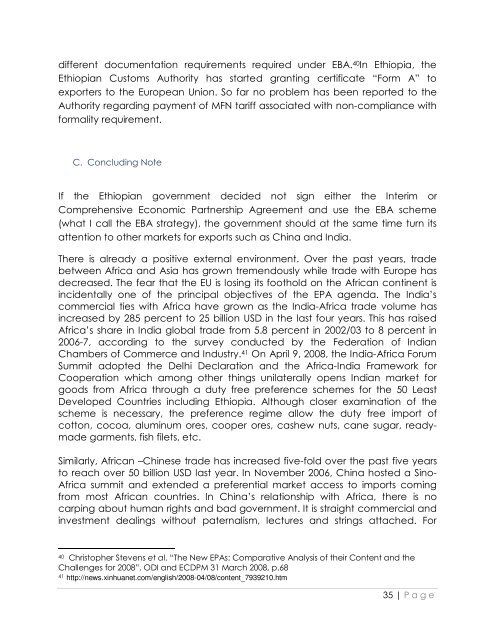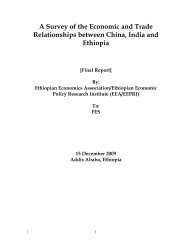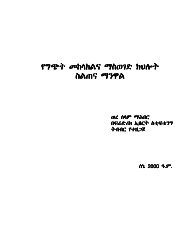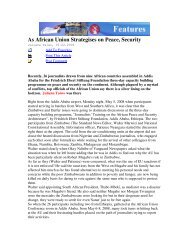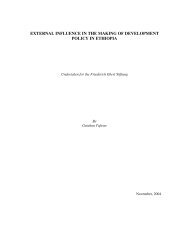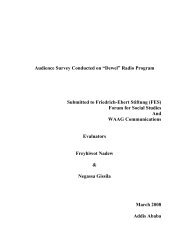Ethiopia and EPA Negotiation 2008 - FES Ethiopia
Ethiopia and EPA Negotiation 2008 - FES Ethiopia
Ethiopia and EPA Negotiation 2008 - FES Ethiopia
Create successful ePaper yourself
Turn your PDF publications into a flip-book with our unique Google optimized e-Paper software.
different documentation requirements required under EBA. 40 In <strong>Ethiopia</strong>, the<br />
<strong>Ethiopia</strong>n Customs Authority has started granting certificate “Form A” to<br />
exporters to the European Union. So far no problem has been reported to the<br />
Authority regarding payment of MFN tariff associated with non-compliance with<br />
formality requirement.<br />
C. Concluding Note<br />
If the <strong>Ethiopia</strong>n government decided not sign either the Interim or<br />
Comprehensive Economic Partnership Agreement <strong>and</strong> use the EBA scheme<br />
(what I call the EBA strategy), the government should at the same time turn its<br />
attention to other markets for exports such as China <strong>and</strong> India.<br />
There is already a positive external environment. Over the past years, trade<br />
between Africa <strong>and</strong> Asia has grown tremendously while trade with Europe has<br />
decreased. The fear that the EU is losing its foothold on the African continent is<br />
incidentally one of the principal objectives of the <strong>EPA</strong> agenda. The India’s<br />
commercial ties with Africa have grown as the India-Africa trade volume has<br />
increased by 285 percent to 25 billion USD in the last four years. This has raised<br />
Africa’s share in India global trade from 5.8 percent in 2002/03 to 8 percent in<br />
2006-7, according to the survey conducted by the Federation of Indian<br />
Chambers of Commerce <strong>and</strong> Industry. 41 On April 9, <strong>2008</strong>, the India-Africa Forum<br />
Summit adopted the Delhi Declaration <strong>and</strong> the Africa-India Framework for<br />
Cooperation which among other things unilaterally opens Indian market for<br />
goods from Africa through a duty free preference schemes for the 50 Least<br />
Developed Countries including <strong>Ethiopia</strong>. Although closer examination of the<br />
scheme is necessary, the preference regime allow the duty free import of<br />
cotton, cocoa, aluminum ores, cooper ores, cashew nuts, cane sugar, readymade<br />
garments, fish filets, etc.<br />
Similarly, African –Chinese trade has increased five-fold over the past five years<br />
to reach over 50 billion USD last year. In November 2006, China hosted a Sino-<br />
Africa summit <strong>and</strong> extended a preferential market access to imports coming<br />
from most African countries. In China’s relationship with Africa, there is no<br />
carping about human rights <strong>and</strong> bad government. It is straight commercial <strong>and</strong><br />
investment dealings without paternalism, lectures <strong>and</strong> strings attached. For<br />
40 Christopher Stevens et al, “The New <strong>EPA</strong>s: Comparative Analysis of their Content <strong>and</strong> the<br />
Challenges for <strong>2008</strong>”, ODI <strong>and</strong> ECDPM 31 March <strong>2008</strong>, p.68<br />
41 http://news.xinhuanet.com/english/<strong>2008</strong>-04/08/content_7939210.htm<br />
35 | P a g e


